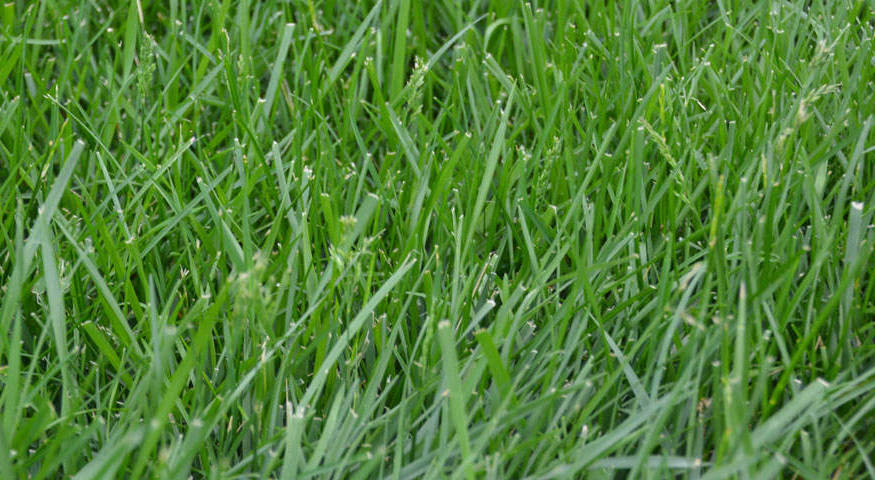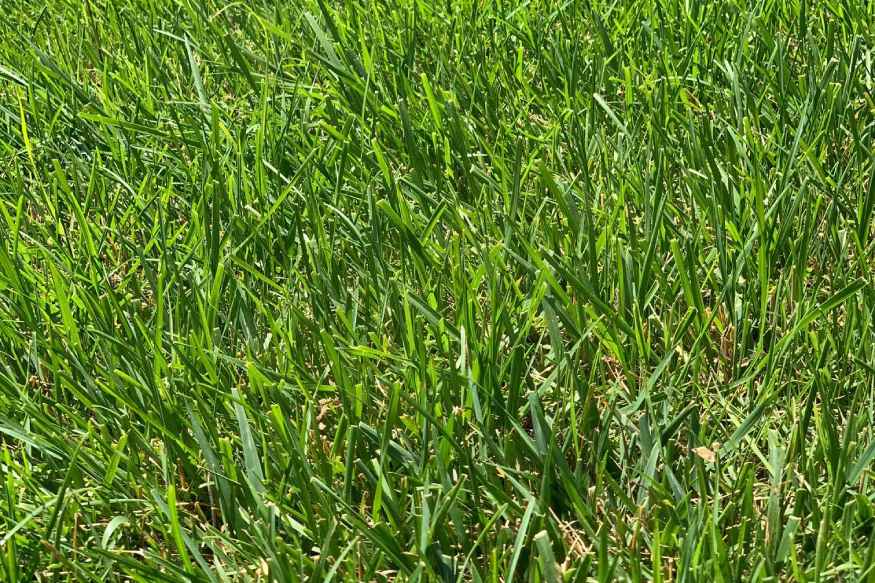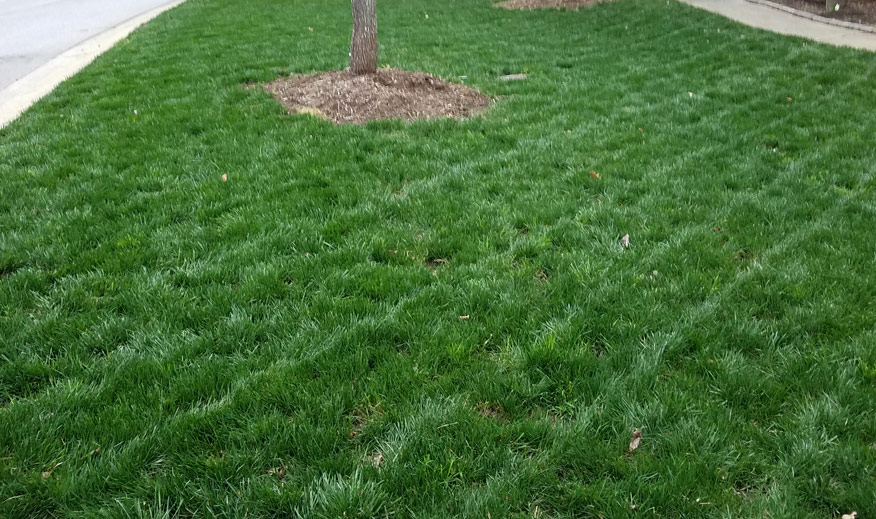Tall fescue is by far the most widely grown cool-season grass in the US, and possibly even the world. And there’s a good reason for it. Tall fescue is very tolerant of cold, heat, and drought, and is low maintenance.
This grass is a good choice for many, but not all, homeowners.
In this guide, we’ll look at important tall fescue characteristics to determine if it’s right for your yard. We’ll also tell you everything you need to know to care for this easy-keeper grass using our tall fescue care calendar.
Tall Fescue Overview
| Also Known As | Lolium arundinaceum (formerly Festuca arundinacea) |
| Type of Grass | Cool season perennial |
| Optimal Zones | Northern through transition zones |
| Root Structure | Deep |
| Winter hardiness | Excellent |
| Shade tolerance | High |
| Water Requirements | Medium to High |
| Drought Tolerance | Excellent |
| Self Repair Capacity | Limited |
| Overall Maintenance Requirements | Low |
History
Tall fescue grass is native to Europe where it grows largely in meadow environments. By the 1800s, tall fescue had made its way to America and become naturalized in the eastern states.
But, it wasn’t until the 1940s that it became intentionally used as pasture grass. It took another 10 years for homeowners to recognize its value as a turfgrass. Once its drought and disease resistance were understood, many selective breeding campaigns began to improve its heat and cold tolerance.
Tall fescue continued to be refined over the next fifty years. Subsequent cultivators were finer in texture and shorter growing.
Like perennial ryegrass, many varieties of tall fescue were bred to contain endophytic fungus. This makes them resistant to insect damage and stress.
Today’s tall fescues are very tolerant of hot summers and cold winters. They can be grown in shade and prefer wet conditions but are very drought tolerant. They are widely used across most of the US in mix and single-grass permanent lawns.
Tall Fescue Characteristics
Tall fescue is a hardy grass with high adaptability that makes it a good choice for a wide range of environments. But it won’t thrive everywhere.
To help you decide if tall fescue is right for your home, let’s take a closer look at the characteristics of this species.
What Type of Grass Are Fescues?
Tall fescue is a perennial cool-season grass. “Perennial” meaning it comes back every spring. And “cool season” meaning it does most of its growing when temperatures are below 75 degrees.
Like Kentucky bluegrass and perennial ryegrass, fescue grows the most in the spring and fall. In mild climates, it can grow throughout the summer and winter as well.
Optimal Zones
Because it is so adaptive, tall fescue is a good choice for homeowners in northern states as well as southern transition zones. In fact, this grass is commonly used as far south as the Mexican border in southwestern states.
Root Structure
Tall fescue has the longest root structure of any cool-season grass. Roots routinely reach depths of three feet. This is why tall fescue is so impressively tolerant of drought.
Note: The roots grow in an annual pattern and die off almost completely in the spring. For this reason, it is important to support root growth and avoid drought stress during this part of the year.
Even after roots have developed, tall fescue requires as much water to thrive as most other cool-season grasses. The difference is, it is much more likely to survive long periods without water than other species.
Winter Hardiness
Tall fescue has slightly better winter hardness than perennial ryegrass. It can survive frequent temperatures as low as 3 degrees Fahrenheit without damage. But it will go dormant at consistent temperatures below 50 degrees, turning brown in the process.
Shade Tolerance
Tall fescue is very shade tolerant and can grow equally well in full sun. Of all the cool-season grasses, it is the best choice for shady and partially shady yards. When grown in areas that get less than 3 hours of sunlight, it’s best to mow to a minimum of 3 inches to maximize photosynthesis potential.
Water Requirements & Drought Tolerance
Despite its deep roots, tall fescue still requires a good amount of water to thrive. Typically, it will need about 1 inch of rainfall or irrigation per week. To encourage deep root growth, only water when grass shows signs of wilting: darker color and drooped or curled leaves.
In the spring, when roots are regrowing, more frequent watering is needed.
Once roots have been established, tall fescue has a great drought tolerance. In hot, dry climates, you can stop watering fescue in the summer and expect it to green back up once the rains start in fall. For homeowners who prefer green grass through the summer, you can achieve this through infrequent deep watering that supplies 1 to 2 inches each week.
Self Repair Capacity
While tall fescue forms some rhizomes, its growth habit is more bunching than spreading. Because of this, it has limited self-repair capacity. High-traffic areas, therefore, are tall fescue’s one major weakness.
Tall Fescue Lawn Care Calendar
Tall fescue requires year-round care to look its best.
For new lawns, spread seed at a rate of 6 to 8 pounds per 1,000 square feet in the early fall. Alternatively, you can set seed in the spring as soon as winter temperatures begin to warm. Sprouts take one to three weeks to emerge.
Once the seedlings have reached 2 inches in height, you can begin following our tall fescue lawn maintenance plan, below.
Spring Care
Tall fescue grows the most in the spring. As such, it requires the most maintenance this time of year.
Mowing
Tall fescue grows best at heights between 2 and 3 ½ inches.
For maximum root growth (in areas prone to drought), leave grass longer throughout the spring. This will support more robust root growth and minimize stress. Mowing to a height of 3 inches is also recommended when excessive weed growth is a problem.
Mow often enough to maintain your goal height without having to take more than ⅓ the leaf length off at a time. Tall fescue has a high growth rate, especially in the spring, so expect to mow every 5 to 6 days.
Fertilization
Too much nitrogen in the spring can result in excessive leaf growth, which reduces root development. Well-established tall fescue lawns can often go without fertilizer in the spring. For newer lawns and those that did not receive fertilization in the fall, we recommend using a product that contains equal amounts of nitrogen and phosphorus to support balanced growth.
Shoot for a rate of ½ to ¾ pounds of nitrogen per 1,000 square feet. Apply when growth begins early in the spring.
Weed Control
Apply a pre-emergent weed control option early in the spring. Use spot control weed killers on young weeds as soon as they sprout or pull them manually.
Thick, healthy fescue rarely has weed problems. For new or thin lawns where weeds are a problem, keep tall fescue longer (about 3 inches) to help crowd out weeds through the spring.
Watering
For a lush lawn, aim for 1 inch of moisture per week. Irrigation is not typically necessary during the first months of spring in most climates. As natural rainfall decreases, begin watering once or twice per week.
Because tall fescue has a deep root system, infrequent, deep waterings are better. Use a corkscrew or soil moisture tester to assess watering depth. Aim for six inches of moisture penetration without excessive water runoff.
Tall fescue can handle drought better than other grass species. However, because roots die off and regrow in the spring, it is best not to underwater this time of year. Grass that is well irrigated in the spring will have better drought tolerance through the summer.
Watering in the early morning is generally the best time. This period reduces water loss while restricting how long foliage stays wet to avoid fungus problems.
Pest and Disease Control
Tall fescue is not prone to insect damage so long as the lawn is not overwatered or overfertilized. When this does happen, it attracts a variety of beetle species whose grubs cause damage.
Treatments for white grub shouldn’t be started until May. Before this time, the grubs are too large to succumb to insecticides. But treatment for any insect should only be applied if damage occurs.
Some older tall fescue cultivators are prone to brown patch disease. This can typically be controlled through balanced watering and fertilization. If it does occur, use a targeted fungicide to eradicate it.
You may also consider overseeding with a newer, more resilient tall fescue cultivator in the fall.
Aeration and Dethatching
Aerating should be done now if it was not completed in the fall. Do it once spring growth is at its peak. This will allow your grass time to recover before the hot summer temperatures.
Tall fescue does not tend to form thatch. However, older lawns may benefit from a good raking every other year to break up any mats that do appear. This can be done in the spring or fall.
Summer Care
Because tall fescue is a cool-season grass, it does not grow much in the summer. If it gets too hot and dry, it may even go dormant and turn brown. Summer maintenance is largely centered around ensuring your lawn gets what it needs to bounce back in the fall.
Mowing
For hot climates, set your mower height to 3 1/2 inches in the summer. This will help prevent sunscald and reduce stress as grass transitions into dormancy.
Growth will slow considerably as the temperature rises over 75 degrees. The grass will likely turn brown and go dormant if increased heat is paired with a reduction in watering.
Watering
To keep grass green throughout the summer, continue applying 1 inch of water per week in one or two watering sessions. As temperatures increase, you will need to increase watering to 2 inches per week.
In hotter climates, it is much more economical to let your tall fescue go dormant. To do this, slowly reduce watering to 1 inch applied in one or two watering sessions every three weeks.
Pest Control
While insect problems are unlikely in the summer, keep an eye out and treat them as needed. Using targeted pest control methods is far more effective than blanket treatments.
White grub treatment will only be effective until August, while grubs are still small and vulnerable.
Overseeding
For new lawns that went dormant over the summer, you may want to overseed your lawn in August. This will help fill any dead spots that do not come back. Because tall fescue is so drought tolerant, mature lawns rarely require this.
Fall/Autumn Care
The fall season is all about preparing your lawn for winter. This means making sure it gets enough nutrients and the right care to survive dormancy and come back stronger in the spring.
Mowing
Cut your lawn to any height between 2 and 3 ½ inches during the fall season. Tall fescue yards struggling with weeds this time of year will benefit from a higher maintenance height.
As rains increase, grass growth will become more rapid. Mow as often as needed (every 5 to 7 days, on average) to avoid cutting more than ⅓ of the grass blade each mowing. Continuing mowing until growth stops.
Fertilization
Fall is the best time to have your soil tested to find out what nutrients are lacking. Choose the right fertilizer to supply these nutrients and apply it in September and again in early November.
This is also the best time to apply a high-nitrogen fertilizer on a tall fescue lawn. Apply this in one session in late October or early November at a rate of 1 pound per 1,000 square feet.
Tall fescue does not typically require a winterizer fertilizer. However, adding this to your fall routine may be beneficial for young and struggling lawns. It is also helpful in climates that experience an especially harsh winter.
Weed Control
Continue using spot control or manual control methods to eradicate weeds. When maintained at a height of 3 inches, most tall fescue lawns do not struggle with weed problems.
Watering
Once temperatures begin to drop at the beginning of fall, start watering as needed to give your tall fescue 1 inch of water per week. Gradually decrease watering to ½ an inch per week starting in mid-October.
Keep an eye on precipitation accumulation after your irrigation system has been winterized. If it’s a dry fall, you may want to hand water to reduce winter stress.
Pest Control
As you did in summer, treat pests only on an as-needed basis. Blanket pest control options are not as effective as targeted measures. Luckily, tall fescue is fairly resistant to insects.
Aeration and Dethatching
Fall is a great time to have your lawn aerated to avoid compact soil if you didn’t do so in the spring. Aerated soil is better able to accept nutrients and water, making for a greener start to the new year.
Have your lawn aerated before spreading your nitrogen-rich fertilizer. This will increase nutrient absorption and give your lawn the best chance of coming back strong in the spring.
If you have an older lawn and did not dethatch in the spring, dethatch now if it’s starting to form mats of dead material.
Overseeding
Fall is the best time to overseed your lawn, if needed. For newer or thinning lawns, overseed with more tall fescue seed to add density. This will help protect against spotty growth in the spring and help crowd out weeds.
Tall fescue is one of the hardiest cool season grasses, but the color and texture are not as sought after as other species. If you want a lusher-looking and feeling lawn, overseeding with Kentucky bluegrass can help. This cool season grass is higher maintenance but provides a picturesque yard with high durability.
By mixing these seeds with your current lawn, you can take advantage of both grasses’ strengths.
Note: Overseeding can be done as soon as fall arrives. Do so no later than 45 days before the first frost in order to give new sprouts time to establish.
Winter Care
In most climates, tall fescue will go dormant through the winter. It will not need much maintenance until it begins to green back up in the spring.
Watering
Watering is typically not needed in the winter. But, if you are experiencing a particularly dry cold season, you may have to hand water on occasion. Shoot for about 1 inch of moisture every 3 weeks.
Overseeding
If you missed your window to overseed in the fall, you can do so in late winter. The best time to do this is February or March when the ground is still moving through thaw and freeze cycles. This will help pull the seed into the soil.
The seeds will begin to sprout just as your mature grass starts to green up. Both Kentucky bluegrass and tall fescue seeds can be put down this time of year.


